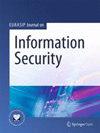RFID tag recognition model for Internet of Things for training room management
IF 2.5
Q2 COMPUTER SCIENCE, INFORMATION SYSTEMS
引用次数: 0
Abstract
With the rapid development of the Internet of Things and intelligent technology, the application of Radio Frequency Identification (RFID) technology in training room management is becoming increasingly widespread. An efficient and accurate RFID system can significantly improve the management efficiency and resource utilization of the training room, thereby improving teaching quality and reducing management costs. Although RFID technology has many advantages, there are still some problems in practical applications, such as label collision and recognition of unknown labels. These issues not only affect the performance of the system but may also cause interference with actual teaching and management. This study proposes a grouping-based bit arbitration query tree algorithm and anti-collision technology to solve label collisions and reduce label recognition time in the technology. A new unknown label recognition algorithm is also proposed to improve the recognition efficiency and accuracy of identifying new unknown labels. Related experiments have shown that the recognition accuracy of the algorithm designed this time is 95.86%. Compared with other algorithms, the number of idle time slots is the smallest. When the number of queries is 1000, the algorithm has 1842 queries, and the communication complexity is the best. When the number of unknown tags is 10,000, the actual accuracy rate is 95.642%. Compared with traditional recognition algorithms, the new unknown label recognition algorithm has a smaller frame length in the same label proportion and good recognition performance. On a theoretical level, the research content on RFID technology helps to improve and develop the basic theories of the Internet of Things and intelligent recognition technology and provides solutions and application technologies for equipment management and IoT applications in training rooms. On a practical level, the research results can provide specific guidance for the management of training rooms, help solve equipment management and safety maintenance problems in practical applications, and improve the management efficiency of training rooms.用于培训室管理的物联网 RFID 标签识别模型
随着物联网和智能技术的快速发展,射频识别(RFID)技术在实训室管理中的应用也越来越广泛。高效、准确的 RFID 系统能显著提高实训室的管理效率和资源利用率,从而提高教学质量,降低管理成本。虽然 RFID 技术有很多优点,但在实际应用中仍存在一些问题,如标签碰撞和未知标签的识别等。这些问题不仅会影响系统性能,还可能对实际教学和管理造成干扰。本研究提出了一种基于分组的位仲裁查询树算法和防碰撞技术,以解决该技术中的标签碰撞问题并缩短标签识别时间。同时,还提出了一种新的未知标签识别算法,以提高识别效率和识别新的未知标签的准确性。相关实验表明,本次设计的算法识别准确率为 95.86%。与其他算法相比,空闲时隙数最小。当查询次数为 1000 次时,该算法的查询次数为 1842 次,通信复杂度最好。当未知标签数量为 10,000 个时,实际准确率为 95.642%。与传统识别算法相比,新的未知标签识别算法在相同标签比例下,帧长较小,识别性能良好。在理论层面,RFID 技术的研究内容有助于完善和发展物联网和智能识别技术的基础理论,为实训室设备管理和物联网应用提供解决方案和应用技术。在实践层面,研究成果可为实训室管理提供具体指导,有助于解决实际应用中的设备管理和安全维护问题,提高实训室的管理效率。
本文章由计算机程序翻译,如有差异,请以英文原文为准。
求助全文
约1分钟内获得全文
求助全文
来源期刊

EURASIP Journal on Information Security
COMPUTER SCIENCE, INFORMATION SYSTEMS-
CiteScore
8.80
自引率
0.00%
发文量
6
审稿时长
13 weeks
期刊介绍:
The overall goal of the EURASIP Journal on Information Security, sponsored by the European Association for Signal Processing (EURASIP), is to bring together researchers and practitioners dealing with the general field of information security, with a particular emphasis on the use of signal processing tools in adversarial environments. As such, it addresses all works whereby security is achieved through a combination of techniques from cryptography, computer security, machine learning and multimedia signal processing. Application domains lie, for example, in secure storage, retrieval and tracking of multimedia data, secure outsourcing of computations, forgery detection of multimedia data, or secure use of biometrics. The journal also welcomes survey papers that give the reader a gentle introduction to one of the topics covered as well as papers that report large-scale experimental evaluations of existing techniques. Pure cryptographic papers are outside the scope of the journal. Topics relevant to the journal include, but are not limited to: • Multimedia security primitives (such digital watermarking, perceptual hashing, multimedia authentictaion) • Steganography and Steganalysis • Fingerprinting and traitor tracing • Joint signal processing and encryption, signal processing in the encrypted domain, applied cryptography • Biometrics (fusion, multimodal biometrics, protocols, security issues) • Digital forensics • Multimedia signal processing approaches tailored towards adversarial environments • Machine learning in adversarial environments • Digital Rights Management • Network security (such as physical layer security, intrusion detection) • Hardware security, Physical Unclonable Functions • Privacy-Enhancing Technologies for multimedia data • Private data analysis, security in outsourced computations, cloud privacy
 求助内容:
求助内容: 应助结果提醒方式:
应助结果提醒方式:


